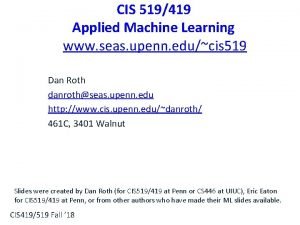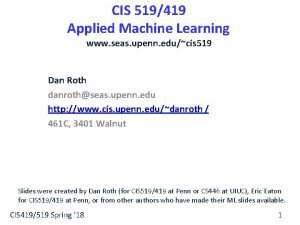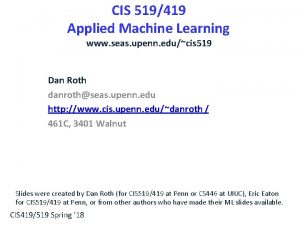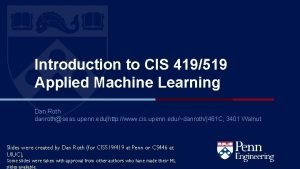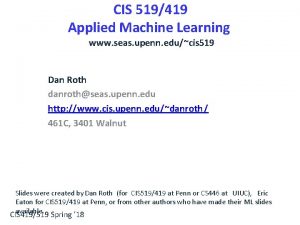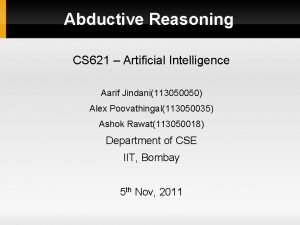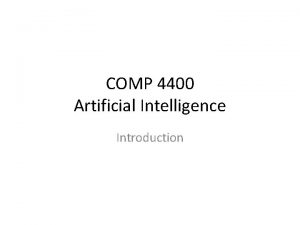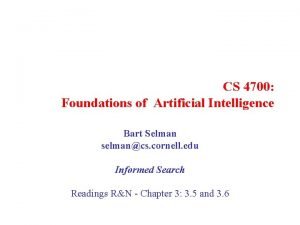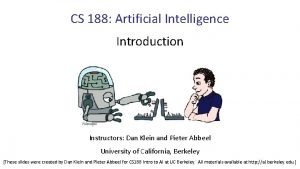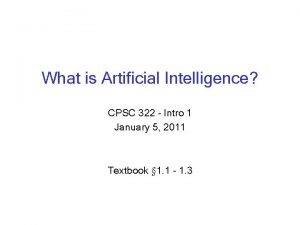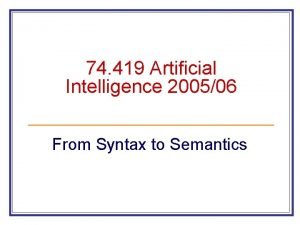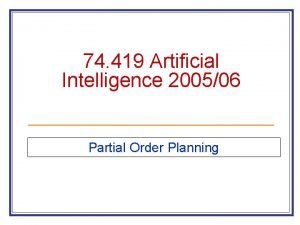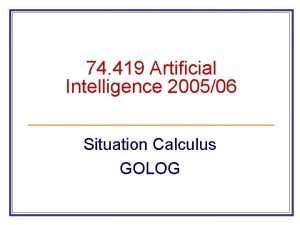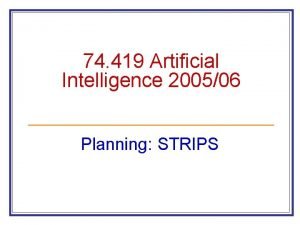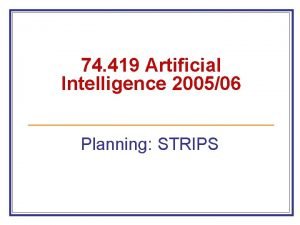74 419 Artificial Intelligence 200506 Features Gaps Movement














![Passives - Example The box was moved. VP[pastprt, +passgap] V[_np, pastprt] moved move is Passives - Example The box was moved. VP[pastprt, +passgap] V[_np, pastprt] moved move is](https://slidetodoc.com/presentation_image_h/1f71839d21beea28a1d9de28b764c678/image-15.jpg)





- Slides: 20

74. 419 Artificial Intelligence 2005/06 Features, Gaps, Movement Questions and Passives

Features, Gaps, and Questions Features n Questions n Passives n Gaps n Movement n

Verb SUBCAT Feature Sample Rule: (VP) (V SUBCAT -np-vp: inf) (NP) (VP VFORM inf) Example: (VP) (want SUBCAT -np-vp: inf) (class) (to end VFORM inf)

Prep. Phrases - PFORM Feature Sample Rule: (VP) (V SUBCAT -np-pp: loc) (NP) (PP PFORM LOC) Example: (VP) (put SUBCAT -np-pp: loc) (the tire) (on the cap PFORM loc)

More Verb SUBCATs Sample Rule: (VP) (V SUBCAT -np-adjp) (NP) (ADJP) Example: (VP) (held SUBCAT -np-adjp) (the cop) (responsible)

Auxiliaries - Some Features Modal Verb form 'past' e. g. did buy person, number e. g. I, you, he, we, they did Complement Verb form 'base' e. g. did buy Verb form 'base' e. g. have paid Complement Verb form 'past participle' e. g. have seen

VP (AUX COMPFORM base) (VP VFORM base) can see have to match (unification) VP (AUX COMPFORM ? s) (VP VFORM ? s) general form VP (AUX COMPFORM ing) (VP VFORM ing) progressive is bringing VP (AUX COMPFORM pastprt) (VP VFORM pastprt) has brought perfect, with past participle

Questions

These characteristics give information about the type of the answer! Category (POS), here: PP-word (prepositional phrase) sentence / phrase: question Q, relative clause R type, here: time specification POS category, here: pronoun agreement, matches: 3 rd person singular or plural type of PP, here: location, motion spec. binary feature POSS: possessive QDET: used as determiner

Rules for NP (noun phrase) Features: POSS, WH PRO question word (possessive pronoun): who, whose (POSS +), which, what from rule 1 (POSS +): whose (book) Complement NP QDET question (determiner): which (book), what (file) PP with NP question: in which store, in whose pockets PP question: where, when inheritance of features

Parsing Question - Which dogs did he see? gap NP missing


Passives

Active and Passive - Example gap NP missing
![Passives Example The box was moved VPpastprt passgap Vnp pastprt moved move is Passives - Example The box was moved. VP[pastprt, +passgap] V[_np, pastprt] moved move is](https://slidetodoc.com/presentation_image_h/1f71839d21beea28a1d9de28b764c678/image-15.jpg)
Passives - Example The box was moved. VP[pastprt, +passgap] V[_np, pastprt] moved move is normally V[_np] np is missing, thus +passgap VP (AUX[be]) (VP[pastprt], +passgap) was moved VP[pastprt, +passgap] (AUX[be]) (VP[pastprt], +passgap) features are inherited downwards / passed upwards from main verb, VP (move, moved)

Movement




Additional References § James Allen: Natural Language Understanding. Benjamin Cummings, 1995
 Cis 419 upenn
Cis 419 upenn Cis 419 upenn
Cis 419 upenn Cis 519
Cis 519 Cis 419
Cis 419 Upenn cis 519
Upenn cis 519 Artificial intelligence
Artificial intelligence Levels of language analysis
Levels of language analysis Artificial intelligence
Artificial intelligence 15-780 graduate artificial intelligence
15-780 graduate artificial intelligence Artificial intelligence examples
Artificial intelligence examples Roman yampolskiy
Roman yampolskiy Conclusion of artificial intelligence
Conclusion of artificial intelligence 15-780 graduate artificial intelligence
15-780 graduate artificial intelligence Artificial intelligence
Artificial intelligence Cs188 artificial intelligence
Cs188 artificial intelligence Semantic network in ai
Semantic network in ai 15-780 graduate artificial intelligence
15-780 graduate artificial intelligence Rule based deduction system
Rule based deduction system Cpsc 322: introduction to artificial intelligence
Cpsc 322: introduction to artificial intelligence 15-780 graduate artificial intelligence
15-780 graduate artificial intelligence Artificial intelligence the next digital frontier
Artificial intelligence the next digital frontier
